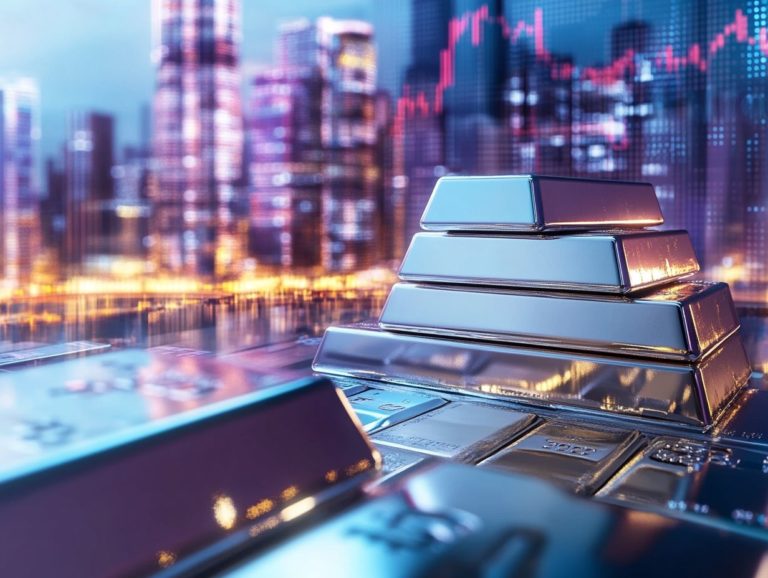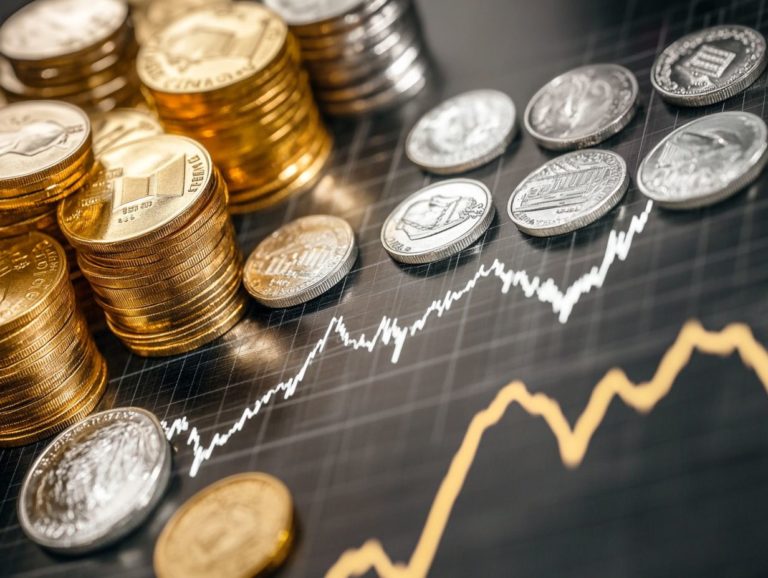The Impact of Inflation on Silver Prices
Inflation stands as an important economic factor that can profoundly influence various asset classes, including silver. As prices escalate and purchasing power wanes, you might want to turn to silver now to protect your wealth against economic uncertainty.
This article delves into the complexities of inflation, examining its direct effects on silver prices. It highlights historical trends that showcase silver’s performance during inflationary periods.
You’ll discover key factors that sway silver prices and effective strategies for investing wisely in this precious metal.
Whether you’re a seasoned investor or just stepping onto the financial stage, grasping these dynamics will empower you to make informed decisions in the ever-evolving market landscape.
Contents
- Key Takeaways:
- How Inflation Affects Your Silver Investments
- Historical Trends of Silver Prices During Inflation
- Factors That Influence Silver Prices During Inflation
- Investing in Silver During Inflation
- Frequently Asked Questions
- 1. How does inflation affect the price of silver?
- 2. Is silver a good hedge against inflation?
- 3. How has inflation historically impacted silver prices?
- 4. Will silver prices always increase during periods of inflation?
- 5. How does the relationship between inflation and silver prices compare to other precious metals?
- 6. Can silver prices also be affected by deflation?
Key Takeaways:
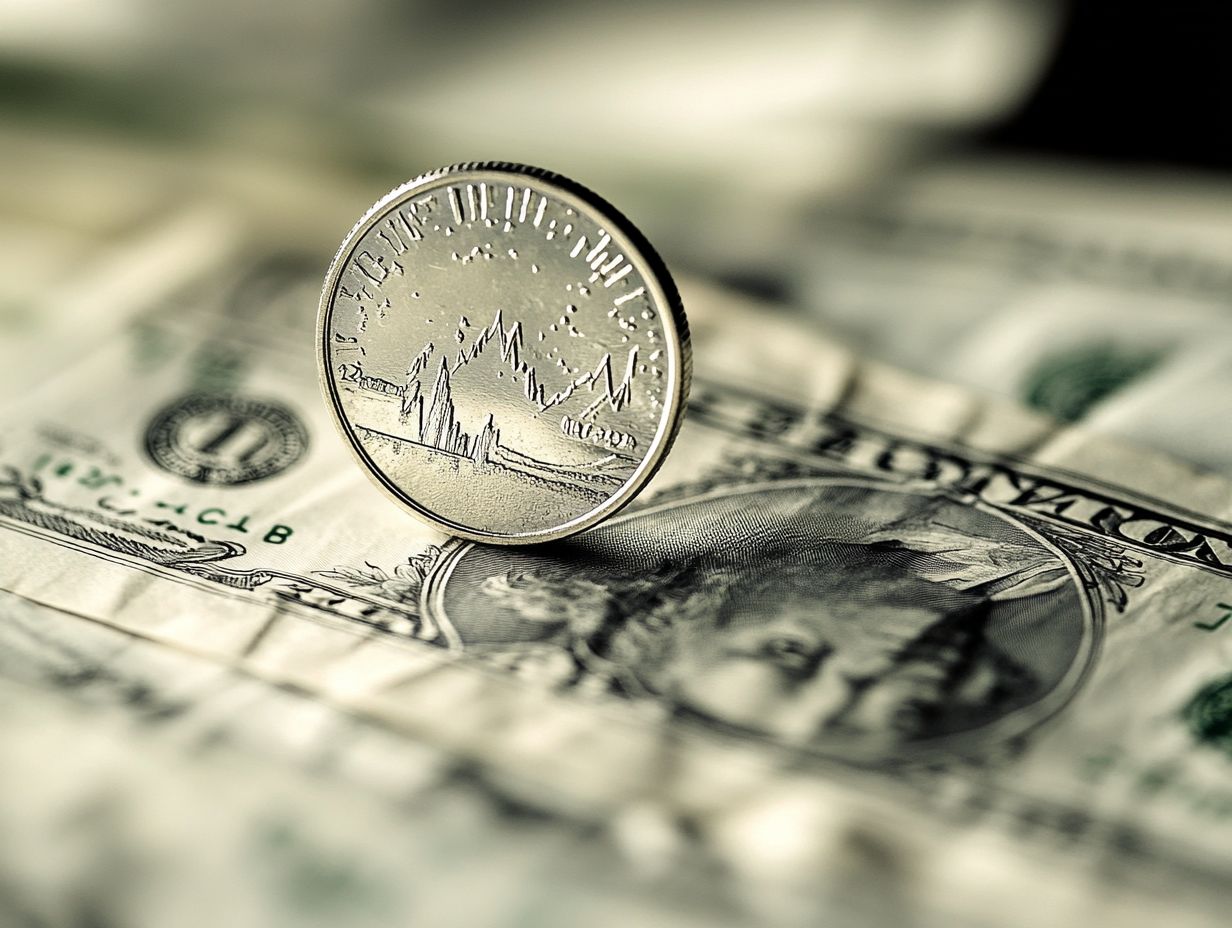
- Inflation is the general increase in prices of goods and services over time, and it can have a significant impact on the price of silver.
- Silver prices have often risen during periods of inflation, making it a potential investment opportunity for those looking to hedge against inflation.
- The supply and demand for silver, as well as economic and political factors, can influence its price during inflation. Understanding these factors is crucial for successful silver investing during inflation.
How Inflation Affects Your Silver Investments
Grasping the nuances of inflation and its impact on silver prices is vital for you as an investor aiming to safeguard your wealth amid economic uncertainty. Inflation, marked by rising prices, can profoundly affect the demand for precious metals such as silver and gold.
As inflation diminishes purchasing power and alters currency values, many investors find themselves drawn to silver as a dependable store of value. This is especially important when the market is unstable, underscoring the importance of understanding how these economic dynamics intersect with your silver investments.
What is Inflation?
Inflation represents the rate at which the general level of prices for goods and services escalates, resulting in a decline in your purchasing power.
This complex phenomenon is usually measured through the Consumer Price Index (CPI), a measure that shows how prices change over time for everyday items. Various factors contribute to inflation, such as demand-pull inflation, where heightened demand for products surpasses supply, and cost-push inflation, which arises when production costs increase, leading to higher prices.
By understanding these types, you can better comprehend how external shocks like surges in oil prices or shifts in tax policies can impact currency values and economic stability. As inflation rises, it doesn’t just affect consumers; it also has significant implications for businesses, influencing investment strategies and ultimately shaping the broader economic landscape.
How Does Inflation Affect Silver Prices?
Inflation has a direct impact on silver prices, enhancing its appeal as a sought-after investment to guard against currency devaluation.
When inflation rates climb, you may find yourself among the many investors seeking refuge in assets that hold their value, with silver often emerging as a top contender. This shift in behavior stems from the broader economic uncertainty that inflation usually brings, prompting you to prioritize stability within your portfolio.
Over the past decades, trends have consistently shown that during periods of high inflation, silver prices tend to rise due to increased demand. You might view silver not just as a store of value, but also as a tangible asset that remains relatively insulated from the volatility of paper currency. This characteristic significantly enhances its appeal during times of economic uncertainty.
Historical Trends of Silver Prices During Inflation
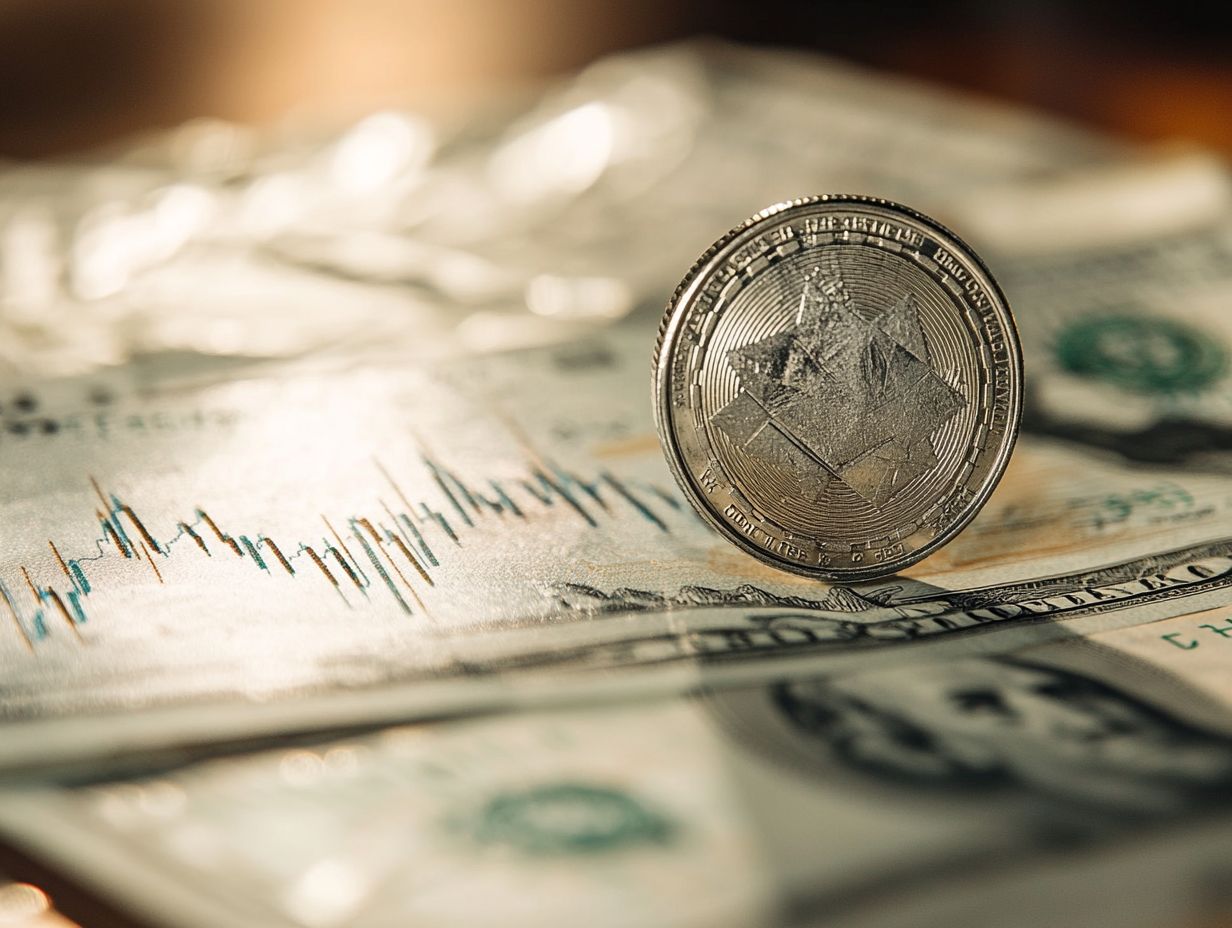
Examining historical trends of silver prices during inflationary periods offers you valuable insights into how precious metals navigate economic challenges. Over the decades, silver has shown impressive price resilience during times of high inflation. It serves as a safe haven for investors worried about market volatility and economic uncertainty.
Notably, in periods of hyperinflation, silver prices have surged. This underscores its enduring reputation as a reliable store of value amid financial turmoil.
Examples of Silver Prices During Past Inflationary Periods
Looking at silver prices during past inflationary periods can provide you with insightful perspectives on how this precious metal behaves as an investment.
Take a moment to reflect on the 1970s. This decade was defined by soaring inflation rates that peaked at over 13% in 1980. During this tumultuous time, silver prices surged from around $1.50 per ounce in 1970 to an astonishing $49.45 per ounce by early 1980.
This dramatic rise illustrates a clear correlation between escalating inflation and the increased demand for precious metals.
Fast forward to the 2008 financial crisis, where uncertainty reigned supreme. Investors flocked to safe havens, causing silver prices to climb from approximately $14 per ounce in 2007 to around $49 per ounce by 2011.
These historical trends underscore silver’s protective nature in the face of economic instability. They reinforce its reputation as a reliable asset during inflationary pressures.
Factors That Influence Silver Prices During Inflation
Several factors influence silver prices during periods of inflation. These include the complex interaction of supply and demand, prevailing economic conditions, and geopolitical tensions.
Understanding these elements is essential for you as an investor aiming to navigate the complexities of the silver market with confidence. Economic indicators, such as industrial demand for silver in sectors like automotive manufacturing, significantly impact price fluctuations.
Central bank policies and investor sentiment also play a crucial role. Geopolitical tensions and trade disputes amplify market volatility, further shaping the investment landscape.
Supply and Demand
The fundamental principle of supply and demand plays a crucial role in shaping silver prices, especially during inflationary periods. As supply constraints tighten and industrial demand surges, particularly from essential sectors like automotive manufacturing, the market feels the pressure.
When global car manufacturers ramp up production in response to rising sales, their increased need for silver commonly used in electronics and components that control emissions can significantly drive prices higher.
This effect becomes even more pronounced during inflationary times. Escalating costs for materials and production spark intensified competition for the limited supply.
Geopolitical tensions and trade disruptions can further complicate the supply landscape. They inflate prices and impact various industries that depend on silver for their operations.
The interaction between soaring industrial demand and constrained supply illustrates the delicate balance that influences this precious metal s market dynamics.
Economic and Political Factors
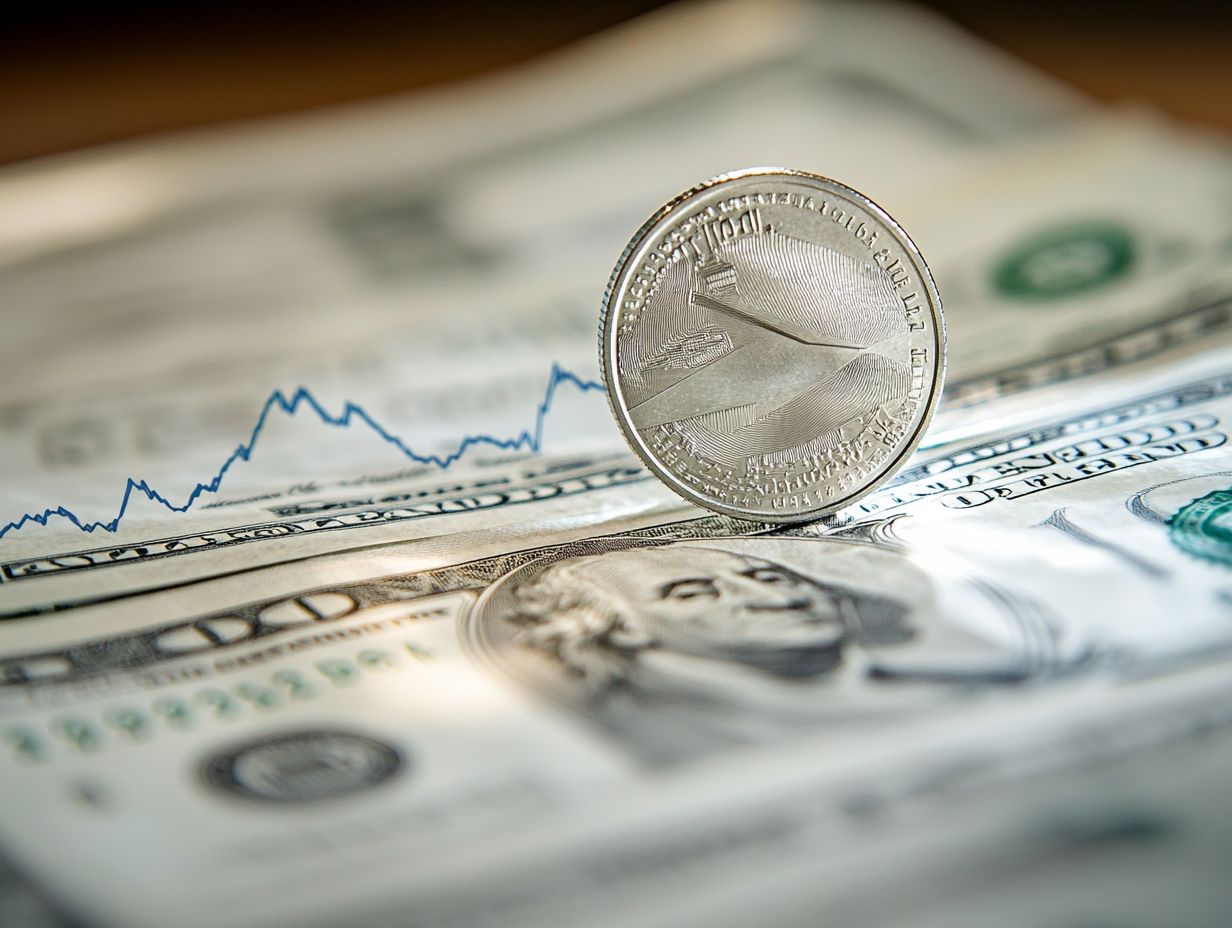
Economic and political factors wield considerable influence over silver prices, especially during inflationary periods marked by geopolitical tensions and shifting central bank policies.
As interest rates fluctuate and Federal Reserve strategies evolve, there is a notable impact on the demand for silver. When central banks lower rates to stimulate economic growth, investors frequently turn to tangible assets like silver.
During trade disputes like those between the U.S. and other nations uncertainty often compels investment into precious metals. This leads to increased volatility in silver prices.
This behavior is largely fueled by the perception of silver as a safe haven asset. Investors seek refuge to preserve their wealth amidst inflationary pressures and global instability.
Don t miss out on understanding how silver can protect your investments!
Investing in Silver During Inflation
Investing in silver during inflation can open exciting opportunities for wealth protection. It s vital to approach this with informed tactics and a clear understanding of the risks involved.
As inflation gnaws away at purchasing power, many investors turn to precious metals like silver. Historically, silver has demonstrated resilience against market fluctuations. Crafting sound investment strategies and exploring various options, such as physical silver or Exchange Traded Funds (ETFs) which are investment funds traded on stock exchanges is essential to navigating this complex landscape.
Strategies for Maximizing Returns
Effective investment strategies are essential for maximizing your returns when investing in silver during inflationary periods. By buying silver regularly over time, you can systematically purchase it at different price points, mitigating the impact of market fluctuations.
Diversification is another key strategy. This encourages including various assets, like silver ETFs, within your portfolio. This approach balances risk while enhancing potential returns.
The intrinsic value of silver often serves as a hedge against inflation. This makes it an attractive option for discerning investors who aim to protect their wealth. Additionally, understanding the effect of inflation on palladium prices can further enhance your investment strategy. By utilizing these strategies, you cultivate a well-rounded investment approach and arm yourself to navigate the unpredictable landscape of market volatility.
Risks and Considerations
While investing in silver during inflation presents enticing opportunities, it s essential to recognize the potential risks and considerations involved. These factors can significantly impact your overall return on investment and the financial stability of your portfolio.
Price volatility is a primary concern. Silver can experience sharp fluctuations in value over short periods. Staying informed about market trends is crucial. Market fluctuations driven by economic conditions and shifts in supply and demand can complicate your investment strategy. Don’t forget about geopolitical risks. Instability in key silver-producing countries can lead to unpredictable price changes.
To mitigate these risks, conduct thorough due diligence by:
- Analyzing historical trends
- Monitoring economic indicators
- Educating yourself on market dynamics
By making well-informed decisions and strategically allocating your resources, you can navigate the complexities of silver investment more effectively.
Frequently Asked Questions

1. How does inflation affect the price of silver?
Inflation decreases the value of currency, making goods and services more expensive. This decrease in purchasing power can lead to an increase in demand for assets like silver, driving up its price.
2. Is silver a good hedge against inflation?
Yes, silver is often seen as a hedge against inflation. Its value tends to increase during periods of high inflation, making it a more stable investment option.
3. How has inflation historically impacted silver prices?
Periods of high inflation have often coincided with an increase in silver prices. For example, during the 1970s, when inflation rates were high, the price of silver rose from $1.29 per ounce to $49.45 per ounce.
4. Will silver prices always increase during periods of inflation?
While silver prices have historically risen during times of high inflation, this is not always the case. Other factors, such as market demand and supply, global economic conditions, and geopolitical events, can also impact the price of silver.
5. How does the relationship between inflation and silver prices compare to other precious metals?
Silver is often seen as a more affordable alternative to other precious metals like gold. However, gold is typically viewed as a stronger hedge against inflation due to its long-standing value and global appeal.
Ready to start your silver investment journey? Consult with a financial advisor for personalized advice!
6. Can silver prices also be affected by deflation?
Yes, silver prices can be affected by deflation, which is when the overall price level of goods and services decreases.
When deflation occurs, the value of silver may decline. Investors often prefer stable options like cash or bonds when demand for assets drops. Keep an eye on market trends! Understanding these factors can help you make informed decisions about your investments in silver.











